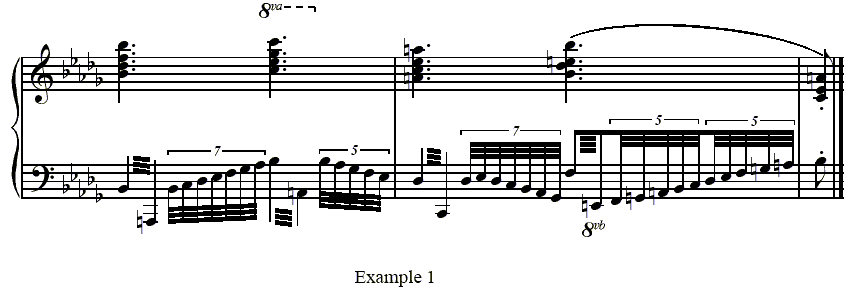
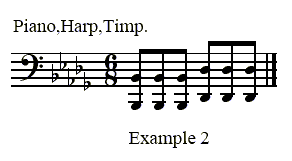
by Barry Drogin
Previous Chapter - Back to guide - Next item in guide - Back to index - Next item in index - Next Chapter
CHAPTER IV : ANALYSIS OF THE SCORE
Oedipus Rex is, above all, a piece of music, and so a consideration of the work should include some description of the form and mechanics of the music. Chapter IV will include a scene-by-scene description of Oedipus with attention directed towards the musical devices employed and their relation to the plot. Also, an in-depth analysis of a specific passage from the score will be presented.
The story of Oedipus, taken directly from the play by Sophocles, is well known. Before the action begins, Oedipus has unknowingly killed his father, Laius, the former King of Thebes, and married his mother, Jocasta. After solving the riddle of the Sphinx, Oedipus is crowned King.
ACT ONE
Oedipus Rex starts with the Male Chorus singing of the "demoralized" city of Thebes, which is suffering from a plague. The five-chord progression in Example 1 is repeated thrice (also note the runs). After only eleven measures, there is an abrupt transition to the 6/8 figure shown in Example 2. It is a very simple, and very memorable, figure, and dominates Act One, returning throughout.
Finally, Oedipus is introduced. Oedipus's major fault is obviously his conceit; having solved the Sphinx's riddle, he brags constantly of his abilities and promises to save Thebes. His vaingloriousness is represented by a jumpy figure in the clarinet (Example 3). IS also has Oedipus always sing arias that, in many critics' opinion, sound "Italianate." The Chorus, returning with the 6/8 figure, implores Oedipus to save them. In a second aria, Oedipus replies, accompanied by a flute/bassoon figure (Example 4) that is very similar to the clarinet figure of his first aria. The music implies a dialogue between Oedipus and the Chorus; Oedipus bragging, the Chorus begging. Peculiarly, the words that Oedipus sings in the second aria tell of Creon's mission --- it isn't vain at all. Since it's Latin, though, it doesn't matter --- an example of IS exercising his freedom to treat the text as "purely phonetic material" (See Chapter II). More text-setting incongruencies will occur.
Creon is revealed from behind a scrim and is greeted enthusiastically by the Chorus with loud G Major chords. Creon begins by singing a broken C Major chord (a simple V - I progression!). IS once explained to a Baritone who was to sing Creon that Creon is obviously representative of the gods because he enters at just the right moment to bring the important news from the oracle. So IS has him sing in C Major in Common time ..."But not for long!" A simple melody (Example 5) is introduced, which returns at the end of the aria as a Folies Bergere tune! Creon's entire aria is largely based on broken chords, such as in Example 6. The return of the beginning melody at the end makes the aria ABA in form.
Oedipus replies to Creon, pulling the key from C to Eb. This is another text-setting incongruency, for, though Oedipus is boasting, his bragging figure is absent (Example 7). Instead, it sounds like Oedipus is putting down Creon for stealing the limelight. He ends with what IS himself has described as Wagnerian 7th chords (Example 8).
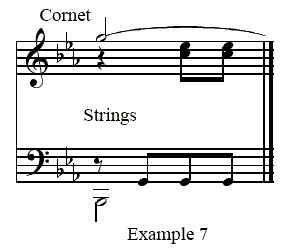
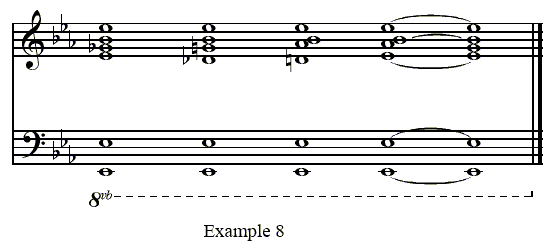
The 6/8 figure of Example 2 returns again. The Chorus sings of the gods and eventually greets Tiresias, the seer, who appears from a cave. The transition is D7 to G (minor, it turns out)! Tiresias refuses to speak (the accompaniment is Example 9). Oedipus flatly accuses Tiresias in four measures. What follows is a marvelous build: Tiresias's "melody" fits into an over-all wave pattern, ending with a climax on high D's (high for a bass). The accompaniment is a static 4/4, starting with the figure in Example 10-a, and eventually inverted to 10-b. Rising chords in the last ten measures before the high D add to the tension. Finally, Tiresias proclaims, "Rex peremptor regis est": The murderer of the king is a king.
Firmly planted in D Major, Oedipus pulls the key up to Eb (again!) via a very lush melody line (Example 11-a), the D transformed into a Major Seventh of the new key. The D to Eb step becomes the major thematic element of the aria (Example 11-b) --- and it took Tiresias, the bass, so long to just reach the D! Oedipus, the tenor, mocks Tiresias, brags a bit, and then accuses Tiresias of conspiring with Creon (the baritone) for his throne, ending with a variant of the minor thirds that dominated the Act. This time the notes are C and Eb, giving Oedipus the chance to hammer away the Eb for one last time, and sounding like a teasing child ("nyaah, nyaah") as he does it.

Jocasta appears, and the Chorus enthusiastically greets her (Example 12). Why so enthusiastically? And why drop the curtain before Jocasta has a chance to speak? Possible answers to these questions will be discussed in Chapter V.
Act Two of Oedipus Rex starts with a direct repetition of the "Gloria!" sung to welcome Jocasta's entrance. The "Gloria" itself consists of C Major chord shouts of "Gloria" (see Example 12) alternating three times with a short canon between the basses and tenors. In his Dialogues (with Robert Craft), IS says that the triple repetition is symbolic of the Holy Trinity, and that "the character of the 'Gloria' music itself is ecclesiastical." In his Harvard Norton Lectures, Leonard Bernstein said the music sounded like Mussorgsky’s Boris Godunov. To each his own.
Accompanied by arpeggiated harp chords, Jocasta starts her aria. The chords, the first two, minor, the second two, sweeping diminished diminished-seven chords (piano added), have a definite familiar out—dated ring to them, and Bernstein places them as Handelian Recitativo. Then Jocasta starts to sing what definitely does sound (again, Bernstein) like a sexy Carmen tune (Example 13), scolding, "Are you not ashamed, princes, to bicker and howl in a stricken city?" An agitated clarinet triplet figure suddenly~ appears (Example 14) as Jocasta warns all to not trust oracles ("oracula"). The word "oracula" naturally suggests a rhythm to IS, and he uses it (Example 15). It is the famous Beethoven rhythm that no one is allowed to use unless they are specifically paying homage to Beethoven. IS uses it anyway.
Jocasta tells Oedipus not to trust oracles, for oracles said that Laius was to be slain by her son (having abandoned her only child to die on a mountain because of that oracle, she is underetandably bitter). The Chorus echos the word "trivium" and Oedipus becomes suddenly afraid --- he killed ("kekidi," Example 16) an old man at the crossroads. Oedipus and Jocasta then launch into a fiery duet, dominated by an agitated triplet figure, Jocasta shouting that oracles are liars and Oedipus demanding to find out the truth. Jocasta’s part is very difficult, a fast succession of sliding minor seconds, and Oedipus’s part is largely based on his "I am suddenly afraid" introduction (which will be analyzed in—depth later in this Chapter) with the "kekidi" figure interspersed.
The Messenger and the Shepherd enter. The Messenger brings word of Polybus's death. Polybus was supposedly Oedipus’s father, but the Messenger declares that he was not. The declaration is made simply, and the music is twice as simple: an Alberti-bass trumpet solo on a C Major chord, a descending C Major scale for trombone and descending G Major scales for the voice (Example 17). The Messenger then tells of how he had found the infant Oedipus abandoned on a mountain. His aria is very interesting rhythmically, alternating between 2/4 and 3/8 in a random fashion (Example 18). The pizzicato string chords give it a very Baroque feel, and when the Chorus repeats the chords as the woodwinds play the melody the impression is reinforced.
Next, the Shepherd speaks. The Chorus has wondered whether Oedipus was born of the gods, but the Shepherd declares that Oedipus was abandoned by his mother and father. He knows. "Silence was better, not speech" surrounds his aria, ABA fashion. The B section is sixteen measures worth of Example 19 --- no harmonic motion, and in typical simple—peasant style (Schubert?). Jocasta, recognizing the Shepherd as the man she had given her baby to, flees in horror.
By now everyone sees the truth; everyone but Oedipus, that is. He sings an ABA aria. At first he thinks Jocasta has fled because she is ashamed of his lineage (the accompaniment is Example 20). Then the 'ce1los and double basses pound out minor thirds in 2/4 as Oedipus starts to brag: he will find out his lineage. And what returns? The clarinet figure from Act One! Then it is a combination of Example 20 and the clarinet figure, with violins and flutes added to the figure, bringing it into predominance.
"On the mountain he was found" repeat the Messenger and the Shepherd, with a variation on the Baroque melody (Example 21). Then there are a few "shudders" (Example 22), and the Messenger, the Shepherd and the Chorus shout the truth: Oedipus is the slayer of Laius, his parent, the husband of Jocasta, his parent!
Oedipus's final solo is given a lot of attention by the critics, primarily because IS manages to express the deep emotion Oedipus suddenly feels with very simple harmonic materials. Another composer might have expressed Oedipus’s realization with loud horrifying dissonances, but IS sees Oedipus as a man suddenly laid bare. The "shudder" alternates between D minor and B minor as Oedipus outlines a B minor chord, with a C sharp passing tone. The major difference between the two chords is the F, which, when sharp, offsets the D minor to D Major. The final five measures (Example 23) pass from B minor to G Major to...D Major or minor? The E sharp trill prolongs the ambiguity for one more second and then, pianissimo, we come to rest in D Major.
The Epilogue is announced by trumpet fanfares that are a cross between Verdi and 20th Century Fox. Then there follows a long build in G minor to the climax: Oedipus's entrance, blinded. The build is engineered out of alternating passages by the Messenger, bringing the news that Jocasta has committed suicide, and the Chorus, filling in the details of how Oedipus broke into Jocasta’s chamber to find her hanging, and then took her brooch and...well, it’s pretty gory. The Messenger is accompanied by octaves and runs (Example 24), reminiscent of the runs in the opening measures (Example 1). The Chorus sings a 6/8 "mortuary tarentella" that sounds annoyingly like an Ivy League Fight Song, with tambourine snaps at the end of each phrase (Example 25). IS has been roundly criticized for this section, many finding it to be inappropriately joyous music.
IS counters this by pointing out the tension—building effect of the static rhythm, and he is correct --- perhaps in a hundred years audiences will be able to listen to this music without perceiving the connection to the popular idiom.
The Epilogue continues to move forward. The 6/8 accompaniment is transitioned into 2/4 sixteenth-note runs by the entire string section. The Messenger speaks for the last time, trombone chords rising on top. Then, Oedipus enters! And it's the five-chord progression (Example l)! But the first chord is Major, not minor. The effect is very dramatic.
Like a calm after the storm, Oedipus ends with the return of the 6/8 minor thirds (Example 2) as the Chorus gently drives Oedipus out of Thebes, bidding him farewell.
FORM AND CONTENT
One can fold Oedipus in two like a psychiatrist’s ink blot. All of the major motives of the very beginning return in reverse order at the end. The "Gloria" adorns the end of Act One exactly as it does the beginning of Act Two. Creon and Tiresias are introduced in Act One, the Messenger and the Shepherd in Act Two.
Most of the arias are ABA, or some variant, like ABCDA or ABAC (where C is a new thought transitioning into a new development). This is, of course, a reflection of the overall form of the piece as previously mentioned.
The orchestration leans very heavily on the woodwinds, primarily the clarinets and hassoons, and the low strings ('celli and double basses). The violins and violas are used so infrequently that they are practically unnecessary, only handling melody during orchestral tutti. The strings as a whole, though, are used effectively for Oedipus's third aria (Example 7), agilely during the Oedipus/Jocasta duet, in the memorable pizzicato chords under the Baroque theme (Example 18) and as the staccato "shudders," and are irreplaceable in the unison 2/4 sixteenth-note runa in the Epilogue. On the whole, however, it would be true to say that the string section and the mistreated brass are primarily used as sound effects in the score.
The arias of Creon, Tiresias, the Messenger and the Shepherd are relatively easy and straight—forward compared to the extremely difficult slides, leaps and flourishes in the arias of Oedipus and Jocasta. Back in the eighteenth century, minor seconds were considered taboo, but IS uses them with a vengeance. Leaps of major sevenths and major ninths also predominate. Though one may draw stylistic parallels to the structure and rhythms of various musical periods, the actual melodies are strictly twentieth—century.
The choral writing comprises some of the beat parts of the score, and one could easily appreciate Oedipus as a choral work with interspersed arias. IS develops many of the devices he will bring to full fruit in the Symphony of Psalms, such as canon, fugue and a new sense of vocal harmony, the last independent of convention. Another device that premieres in Oedipus before the Symphony of Psa1ms is a slowed—down version of polyrhythm, where a bass pattern is established and repeats unchanged while the voice varies its stress independent of the bass. For example, the 6/8 minor thirds in the beginning are between Bb and Db, yet the downbeat varies between them. This, of course, was used best in the final movement of the Symphony of Psalms: the bass moves relentlessly through the same three notes as the voices sing in 4/4.
A SHORT ANALYSIS
It might be instructive to examine a small passage in—depth to see its workings. The following ten measures are from the piano reduction by the composer and form the introduction to the Oedipus/Jocasta duet:
The key moves from to Bb to G. Rather than move through a chord progression, say Bb-Eb-C minor-G-C Major-D-G, IS slides down to Gb, calls it F#, and then slides up to G. In the first seven measures most of the sliding is done by the minor thirds as shown below, while the Bb-F bass sustains throughout (like the sustain at the end of The Firebird). Once Gb is reached, the bass becomes unfrozen and starts to wander; meanwhile, F# (Gb) is changed to F# minor, which naturally resolves to the G chord. Though the elements are scattered, what happens next is the G moves down through F# to F natural and right back up again. The bass G confirms the replanting of the key.
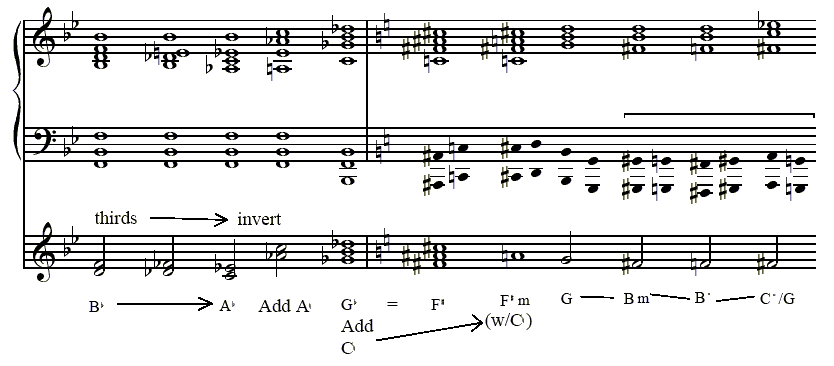
This chromaticism is, of course, reminiscent of the chromaticists, namely Chopin and Liszt. But there are added touches, like the A natural that conflicts with the Ab chord and is reinforced in the voice, the similar presence of the C in conflict with the F# chord, and the random movement of the bass at the end that defies harmonic analysis with relation to the rest of the orchestra. IS liked to combine elements that were very simple alone but clashed together. Here, using such simple elements as a chordal progression with a bass line, IS has created new harmonic sounds.
The vocal line is both simple and difficult. The contour is simple. But note the sliding minor seconds in neasures 1, 2 and 5, and the tritones in measure 7. And then there are the broken chords in measures 8 and 9, a sad illustration of the limit of IS’s melodic abilities. Hansen is correct in stating that IS will not be remembered for his sense of melody.
Tempi and some notational details subject to verification.
This is Chapter IV of "Stravinsky's Oedipus Rex: The Handelian Ring," written in May of 1980 and, nearly 25 years later, realized on the Internet using GIF and MIDI files to visually and aurally illustrate the examples. I first perceived such a project in 1999, five years prior, as discussed in my Introduction to "A Musical Contrarian". I am thrilled to finally bring this project to fruition.
Previous Chapter - Back to guide - Next item in guide - Back to index - Next item in index - Next Chapter
A Musical Contrarian © 1980, 1999-2007 rights@notnicemusic.com